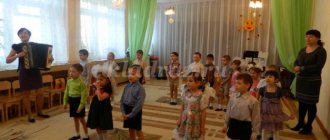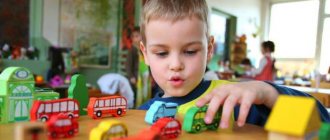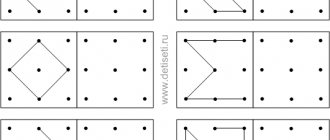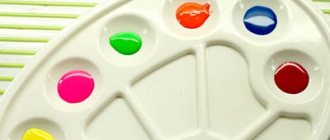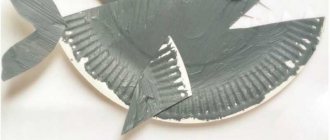Notes of music lessons for the senior group, children 5-6 years old
Goal: development of children's musical and creative abilities in various types of musical activities.
Equipment:
- music Center;
- projector;
- children's musical instruments: metallophone, tambourine, wooden spoons; noise instruments: sticks, balloons, bags.
Musical series: N. Rimsky-Korsakov “Lullaby”, D. Shostakovich “Waltz Joke”, “On the Mountain Kalina” Russian folk melody arranged by Y. Chichkov, “On a Sleigh” by L. Timchenko.
Greetings
The music director hums: “Hello boys!” The boys answer, singing: “Hello!”
The music director hums: “Hello girls!” The girls answer, singing: “Hello!”
Musical director: - Now let’s say hello to the guests! The children turn to the guests and sing: “Hello guests!” The guests answer: - Hello!
Motivation
Musical director:
— Guys, do you like fairy tales? (yes), do you write fairy tales? (children's answers). I have composed a musical fairy tale for you, do you want to become its hero? (Yes).
Acquaintance
Ri
Musical director: (slide with an image of the winter kingdom) - In a certain kingdom, in a certain state, there was a beautiful kindergarten, beautiful and inquisitive children went to the kindergarten. When they first met, they immediately began to get to know each other, but they got to know each other in an unusual, musical way.
Want to know how? (yes) Then sit in a circle (on your knees). What is your name? (Masha). What does your mother affectionately call you? (Mashenka).
The child claps the rhythm with his palms (2 claps - MA-SHA), and the children clap the rhythm with their palms on their knees (3 claps MA-SHEN-KA).
Rhythmic chanting with sticks
Musical director: — And then one day, on a beautiful day, what day was it according to the time of year? (winter). So, on a beautiful winter day, the children went for a walk in the winter forest. What can you use to go into the forest in winter? (children's answers). Let's go sledding and skiing to ride down the hills and hills. Sit on the “sleigh” (chairs), we’ll go, and so that the ride doesn’t get boring, we’ll sing a song.
(slide showing children on sleds and skis)
“One, two, three, four, five, We’re going, we’re going for a walk. (We’ll ride down the snowy hill with you! Oooh-ooh-ooh!”)
Musical director:
— Now let’s get on our skis and take our sticks (sticks under the chairs).
Singing a song with sticks.
Breathing exercise
Musical director:
(slide with an image of a forest clearing)
- Now the children have reached the forest, but how fresh is the air in the forest, what does it smell like? (Christmas trees). The children began to breathe fresh air and enjoy the beauty. And we will take a deep breath of fresh air through our nose, and as we exhale we will happily say “Ah!”
Active perception of music
Improvisation to the music of N. Rimsky-Korsakov “Lullaby” Dance of the winds and snowflakes to the music of D. Shostakovich “Waltz Joke”
Musical director: “So the children inhaled the aroma, inhaled it, and began to look at the forest picture. And what did they see in the clearing? (answers) What mood does the picture convey? And then it seemed to our children that something was missing in the clearing. What would you add that is missing? (answers). How would you and I add brightness to this picture to make the clearing more beautiful and brighter? (children's answers) So the guys from a certain kingdom-state decided to become artists and decorate the clearing. Well, we will decorate it not with paints and pencils, but with hand and body movements accompanied by beautiful music. What would you draw? (sun, snow, clouds...)
Children draw figures to the music of N. Rimsky-Korsakov “Lullaby”, then dance with snowflakes to the music of D. Shostakovich “Waltz Joke”.
Musical director: Do you want to see what happened? (slide with an image of a bright forest clearing) How our clearing has been transformed, you are real wizards!
Voice-over of the poem “On a Sleigh” by L. Timchenko
Musical director:
— While the children were dancing and playing, Zimushka-Winter herself came to them and gave them a beautiful box. Look, what is this? What instruments do you know, what are they made of? Play and listen to how they sound. And so our children came up with a game with instruments and began to play.
We are going, we are going on a sled, we are going, we are going on skis, (claps on the knees, on the floor, on the palms) One, two, three. The snow creaks underfoot, (bags of starch) A woodpecker knocks on a branch, (spoons, sticks) A magpie crackles on a tree. (ratchet)
We are going, we are going on a sled, we are going, we are going on skis, (claps on the knees, on the floor, on the palms) One, two, three. And the snowflakes swirl, fly (metallophone, triangle, bells) and melt on the palm of your hand.
We are going, we are going on a sled, we are going, we are going on skis, (claps on the knees, on the floor, on the palms) One, two, three. A squirrel on a branch is gnawing nuts, (nuts) A horse is pushing a sled in the snow. (tambourine…)
We are going, we are going on a sled, we are going, we are going on skis, (claps on the knees, on the floor, on the palms) One, two, three. Suddenly the wind and blizzard came (tubes) and made noise along the branches. (paper,..)
Orchestra “On Mount Kalina” Russian folk melody arranged by Yu. Chichkov
Musical director: — And suddenly beautiful, playful music began to sound in the forest, the children took their instruments and began to play in the orchestra. Let's try to play in an orchestra, I will be the conductor and show with my hands which group to play.
Children take instruments and play in the orchestra
Musical director: - Do we have a beautiful orchestra? As a farewell, Zimushka-Winter gave the children balloons, but the children were such entertainers that, returning home, they sang a song while playing on balloons.
“One, two, three, four, five, We went for a walk in the forest. Here we are returning home from the forest clearing!
Reflection
Musical director: - Well, guys, did we have an interesting fairy tale? What title will you come up with for our fairy tale? What did you like? Will you come up with your own fairy tale? Who will you tell it to? Will you teach someone to play with balloons at home? What else can you teach me to play? What tools can you make at home?
The music director hums: “Well, now let’s say goodbye to you, musically.”
Goodbye boys! The boys answer, singing: “Goodbye!”
The music director hums: “Goodbye, girls!” The girls answer, singing: “Goodbye!”
The children turn to the guests and sing: “Goodbye, guests!” (Guests answer).
The importance of music classes in the senior group of preschool educational institutions
Music classes are conducted throughout all years of preschool education. Music is an extraordinary means that teaches us to perceive the world around us through sound aesthetics and emotionally-filled works. The classes provided give children joy, a positive charge of energy, a good mood, and develop a sense of rhythm and melody.
Scientifically proven fact. Music lessons contribute to the development of a child’s intellectual abilities.
In the older group, children need to be actively introduced to various musical instruments and taught the basics of playing them. Musical activities of a rhythmic nature, such as rhythm, movements to music, and various musical performances, are also welcome. It is necessary to show preschoolers how to perceive the world through musical means.
Music lessons develop aesthetic taste and intellectual abilities
The goals of music classes in the senior group may be the following:
- developing the creative abilities of preschoolers with the help of music;
- increasing interest in music;
- development of musical ear, rhythm, plasticity;
- education of a harmoniously developed personality.
The tasks vary depending on the type of activity, but the main ones can be identified:
- developing interest in musical activities;
- development of abilities and skills in a certain area (vocals, playing a musical instrument, rhythm);
- formation of musical culture.
Techniques relevant for the older group
- Gaming techniques. Introduction to the art of music through play creates optimal conditions for instilling a love of beauty and developing the creative abilities of students. unexpected appearance of toys,
- improvisation games,
- educational games,
- creating a game situation.
Since play is the leading activity in preschool age, gaming techniques will be relevant for pupils of all groups of preschool educational institutions.
Types of music classes
Music classes vary in content. It could be:
- A typical music lesson is a traditional music lesson that includes performing, listening and mastering a piece of music. The structure of this type of lesson can be different. For example, you can start by listening to some famous piece or, conversely, first the children sing a learned song in chorus.
- A dominant music lesson is a type of lesson whose emphasis is on something specific. For example, learning a musical instrument, mastering rhythmic techniques, developing hearing, etc.
- An integrated music activity is characterized by the use of various activities together with music. For example, a combination of music and artistic creativity (drawing, modeling, dance, theater activities), music and reading a literary work, music and architecture, music and sports. This kind of classes is more complex in its structure, so it is recommended to start introducing them from the middle group of preschool educational institutions. They are held no more than once a month.
- A thematic lesson highlights a specific topic that unites all types of children’s musical activities, on the study of which the entire course of the lesson is based. For example, the theme “Seasons” or “Fairy Tales in Music”, etc.
In the older group, children actively learn to play musical instruments
Depending on the number of students participating in the lesson, there are:
- individual sessions;
- music lessons in subgroups;
- group music lessons.
Synopsis of musical GCD in kindergarten. Senior group
Musical educational activity in the senior group on the topic “Journey to the Land of Music”
GOAL OF THE CLASS: creating conditions for the musical, emotional and moral education of children; OBJECTIVES: * repeat and consolidate knowledge about musical and noise sounds; * create a warm, joyful, “sunny” mood in class; develop the ability to feel and convey emotional warmth and joy to others; * develop musicality through the combination of various sensations: visual, auditory, tactile, motor - in the process of playing music; * instill a love of music. * cause emotional uplift. PRELIMINARY WORK: * selection of musical material; * selection of visual material. ATTRIBUTES AND EQUIPMENT: demonstration material;
musical instrument: synthesizer; music Center; children's musical instruments. PROGRESS OF THE CLASS
Children enter the music room in a line to the music, performing a round dance step.
Musical director: Hello, guys! How are you feeling? It's so nice to say hello to each other. Guys, today guests came to our music lesson, let’s say hello to them too! You and I know a very interesting greeting game called “Hello”! So, get ready! Begin! Game-greeting “HELLO” I say hello everywhere marching movements
At home and on the street, Even hello, I say
waving with my right hand
On the next street.
Hello, the sky is blue, they raise their hands up
Hello, the sun is golden,
they cross their hands, spreading their fingers
Hello, a light breeze,
shakes their hands raised up
Hello, a small oak tree,
connects the wrists of the hands, spreading the hands
Hello, morning,
a soft gesture of the right hand to the right
Hello , day,
the same gesture with my left hand to the left.
I’m not too lazy to say hello.
clap with both hands Musical director: Well done, guys! And now I ask you to go to the chairs! Children walk in a round dance to the music and sit down on chairs. Musical director: You know, guys, this morning I walked into the music room and saw that some bright, bright lights were shining on our carpet. I was surprised, ran up and managed to grab only one light, the rest disappeared. Look what I have left in my hands. Look at some flower. What kind of flower is this? (children's answers) Music director: Let's count the petals. How many petals? (children's answers) Musical director: It seems to me that this flower appeared here for a reason, it invites us somewhere. Have you met this flower in any fairy tale? (children's answers). This is probably that same magical flower. Well, let's go where he calls? (Yes). Musical director: Then let's close our eyes and say the magic words: “Fly the petal through the west to the east, through the north through the south, return by making a circle. As soon as you touch the ground, we have to do it our way! Children pronounce words with their eyes closed. Magic music sounds. The staff opens. Musical director: Where are we? Oh, what is this? (pointing to the staff) 1. Who can remember the name of the house where the notes live? (staff) 2. How many lines are there in the stave? (5) 3. What is the name of the “king” of all notes? (treble clef) 4. How many notes are there in the musical palette? (7) Let's sing them. Children sing a scale Musical director: Guys, you and I know a very interesting song that is sung only within our scale! Who can tell me what it's called? (children's answers) That's right, let's do it now. Let's all get back on our feet and perk up a little. We put our pen in front of you so that it can help you when singing and we perform together with me to the count! Are you ready? Begin! Children perform the song “The cat took a taxi.” Musical director: Well done guys, do you want to continue our journey? Then we tear off the second petal. “Fly the petal through the west to the east, through the north through the south, and return after making a circle. As soon as you touch the ground, we have to do it our way!” The dance music “Magic Flower” is playing. Musical director: Guys, hear, some kind of music is playing. What kind of music is this? What kind of music is this: song, march or dance? (Dance) Musical director: That's right, we found ourselves in the city of dance. And today our lovely girls have prepared an amazing dance for all of us, which is called “Magic Flower”. Dance with flowers “Magic Flower” Musical director: What magical flowers grow in kindergarten. Did you like it? Shall we go further? “Fly the petal through the west to the east, through the north through the south, and return after making a circle. As soon as you touch the ground, we have to do it our way!” Drum music sounds Musical director: Oh, how interesting, where did we end up? Maybe the music playing can tell us? What can we call it? Guys, let's listen one more time, can we hear the melody? (NO) What do you hear? (Drum) But this is also music. And we found ourselves in the city of rhythmic sounds. Guys, please tell me what sounds are there? (noise and music) Children know everything in the world. There are different sounds. The farewell screech of cranes. The loud rumble of an airplane. The rumble of a car in the yard. The barking of a dog in the kennel, the sound of wheels and the noise of a machine, the quiet rustle of the breeze. These are sounds - noise, Only there are others: Not rustling, not knocking - Musical sounds are sounds Musical director: What kind of musical sounds are there? (quiet-loud, high-low) Please show me on the staff where the low sounds are? Where are the high ones? Now let's all turn into musicians and try to play with an orchestra! “Noise Orchestra” Musical director: What great fellows you are! Shall we continue on our way? “Fly the petal through the west to the east, through the north through the south, and return after making a circle. As soon as you touch the ground, we have to do it our way!” The musical composition “Sunny Circle” is playing. Musical director: Some kind of music is playing again. Doesn't she happen to be familiar to you? What is this? (SONG) That's right, because we are now in the land of songs and the gentle sun is shining for us and the song is also sunny. Let's have this beautiful and wonderful song. Children perform “Sunny Circle” Musical director: What great fellows you all are. You sing wonderfully, dance very beautifully, know everything about notes, and play musical instruments well. It seems to me that even our seven-flowered petals have become brighter. Look, we still have petals on the flower, let's count how many there are. (3) Only today we won’t cut them off, because the magical world of music is so huge and we still have a lot to travel through it and learn a lot about music, and the seven-flowered flower will help us with this. And now it’s time for us to return to kindergarten, let’s close our eyes and ask the flower to take us back. Children close their eyes All together: Flower take us back to our beloved kindergarten. MUSIC SOUNDS, children open their eyes Musical director: So we have returned from our wonderful journey. Did you like it? Please tell me what you remember most about our trip? (children's answers) Musical director: What a great fellow you are, I am very pleased with our lesson, and in memory of the trip I want to give you small and cheerful notes. The musical director distributes notes. I want to thank you guys for such a wonderful activity and invite you to the next one. I will be waiting for you impatiently. And now let’s finish our lesson with a farewell song called “Goodbye, guys!” Children come out in a line to the music from the music hall, performing a round dance step
We recommend watching:
Integrated lesson with presentation for children of the senior group on the topic: Autumn Music lesson in the senior group with TRIZ elements: Seasons Complex music lesson using health-saving technologies in the senior group Music lesson in the senior group on the topic: Winter
Similar articles:
Musical lesson using logorhythmics in the senior group of a preschool educational institution
Rhythm lesson for middle and senior kindergarten groups
Musical lesson in the senior group. Abstract
Summary of the lesson “Birds in winter.” Senior group
Complex lesson in the senior group of kindergarten according to the Federal State Educational Standard
Music-themed music lesson for children of the senior group Topic: “Mom is the main word!”
Transcript
1 Music-themed music lesson for children of the senior group Topic: “Mom is the main word!” Goal: development of children’s musicality, the ability to emotionally perceive music. Objectives: expand ideas about holidays; develop the ability to characterize music and situations; continue to improve children’s artistic and speech skills when reading poems and performing songs (emotionality, naturalness, the ability to convey their attitude to the content with intonation, gesture, and facial expressions); evoke a vivid emotional response when perceiving music of a different nature; cultivate a caring and sensitive attitude towards the person closest to you. Children come to the music, stand in a circle, and say hello. Musical director: Guys, I know that you like to solve riddles, so Kira has prepared a riddle poem for you. (child reads a poem) Kira: Who came to me in the morning? Who said: “It’s time to get up?” Who has already cooked the porridge? Who poured tea into my cup? Who as a child loves laughter? Who is the best in the world? Children: Mom! Musical director: Guys, why did Kira prepare a riddle for you about your mother? Children: Because Mother's Day is coming soon. Musical director: Guys, in Russia Mother’s Day is celebrated on the last Sunday of November. What do people do on this day? (Congratulations to moms). How can you congratulate? Sing a song, read a poem, make a postcard or craft with your own hands. They also say kind, pleasant words to mothers and give compliments. Let us also praise our mother and play the game “Continue the Sentence” Game “Continue the Sentence”
2 (music director begins, children continue) - My mother is the best - My mother knows what to do best - My mother is happy when I - My mother is upset when I - I like it when my mother - I affectionately call my mother Children perform a song “The little dawns are more beautiful” Musical director: Well done, let’s sit on the chairs. (Children sit in a semicircle) Musical director: Listen to the story I want to tell you. A long time ago, more than five hundred years ago, in the distant country of Italy, there lived a boy with the beautiful name Raphael. The boy Raphael had real talent as an artist. One day he told his father: “I want to learn how to paint so that in my paintings there will be blue skies and beautiful faces of people. Let people look at my paintings and forget about everything in the world.” Little Raphael's dream came true. He became the greatest artist. Raphael Santion painted beautiful paintings known all over the world. He dedicated many of them to women. And his paintings depicting a woman-mother are especially beautiful. The painting “The Sistine Madonna” is considered one of his best works. (shows a slide) Look, this is a woman with a child. The artist depicted the mother woman as a goddess. Look at the Madonna's face? (beautiful, kind, gentle, calm, thoughtful) What do you think she is thinking about? (About the fate of your child). But the woman-mother was praised not only by artists, but also by composers. How does the composer express his feelings? (With the help of music). Let's listen to the piece, a musical portrait of a woman-mother. This is a song performed by an Italian children's choir. “Ave Maria” by F. Schubert sounds. Musical director: This beautiful music was written by the Austrian composer Franz Schubert. What is the nature of the music? (The music is tender, calm, pure, beautiful) Schubert, just like Raphael, admires the woman-mother. “Ave” means “Glory.” “Mary” is the image of a mother. “Ave Maria” - the singer sings, i.e. "Glory to the Mother!" Glory to her love, her care, her kind heart!
3 Musical director: Now I’ll ask everyone to stand in a circle (children stand in a circle) and let’s play the game “Pass the Heart.” I’ll ask you to tell about your mothers. What are they? What kind words about your mother do you know? Standing in a circle, taking turns, we will pass the heart to the neighbor on the right side, on whom the music stops, he must say an affectionate word about his mother (For example: affectionate, gentle, kind, good, beautiful, loving, cheerful, caring, and so on.) Musical director: Well done! All children completed the task. Today we played well, but we haven’t danced yet. I’ll ask everyone to stand in pairs and let’s dance together! Children perform the dance “Turn Around” by Evtodieva Musical director: Children, I know that you all have kind, beautiful and affectionate mothers, but they are all different. Arisha's mother looks like a sorceress, listen to her poem: Arisha: Mom is like a sorceress if she smiles Every wish I have comes true A kiss from my mother - the bad is forgotten A new day, a cheerful day Begins right away. Musical director: But Lena compares her mother to the warm sun. Lena: How this happens, I myself don’t understand. That the sun is in the sky, then my mother is in the house. The sun will suddenly hide behind a cloud. Everything will become empty and sad around. My mother will leave for a while. I will become so sad. My dear one will return home and I will become cheerful again. I play, I laugh, I tumble, I sing. I love my dear dove!
4 Musical director: Also listen to the poem “The Heart of a Mother” They will tell it.. (children come out and recite the poem) The Heart of a Mother... Olga Grazhdantseva 1st child: The heart of every mother A mesh of scars Every cry of a child is a tiny scar Broken knees, Blood from a finger - wreaths Without such marks, mothers have no hearts. 2nd child: Cough and sore throat, Fever in daughter, son. Chickenpox spots, sleepless nights. Dentist's office. Fear and tears again. Mother holds it in her heart. 3rd child remembers everything in full: First grievances. - Small in appearance Only the mother’s heart feels their pain With each new scar The mother’s heart is hotter - “Don’t be afraid, baby, I’m always with you.” 4th child: The suns grow up, Quarrel, get sick, Understand the turns of adult life But mothers are still the same Collecting scars Imprints of pain Sharp knives 5th child: This connection, like a miracle, Stays everywhere Mom will take away half of the pain If she can do more, If only it lasts longer She had enough strength... I wish I knew in advance
5 6th child: If necessary, Mom will be there You need to take a deep breath, you need to be silent The heart of every mother A mesh of scars But without these scars the heart does not beat Musical director: Now find out by the melody what kind of song this is? (performs a fragment of the work) That's right. This is the song “Baby Mammoth” by Vladimir Yakovlevich Shainsky. Watching the cartoon “Mom for Baby Mammoth” Musical director: Remember what other songs about mom we know? Standing near the chairs, we will sing the familiar song “Mama is a ray of sunshine.” Children perform a song Musical director: Now come out, all the guys, to dance “Merry Dance” by Evtodieva Musical director: What do you remember most? What did we do? What new did you learn? What songs did you sing, what dance did you perform, what did you listen to, what game did you play? For the fact that you sang, danced, and recited poems well, I will give you hearts as a souvenir as a symbol of love and kindness (the music director gives out hearts to the children)
